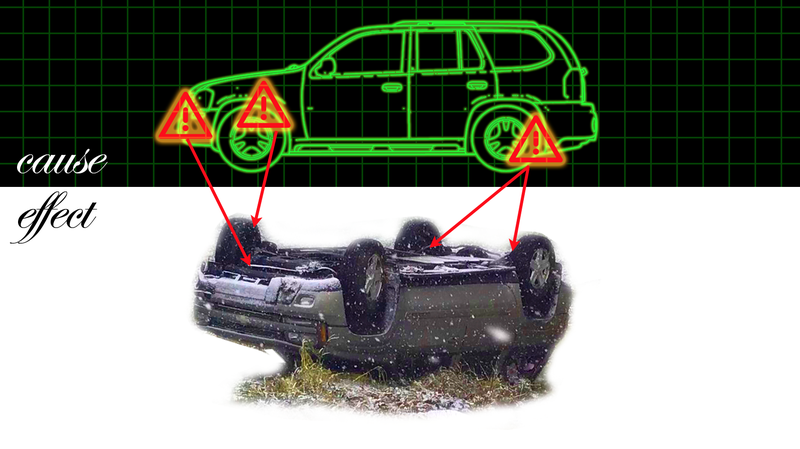
To some car enthusiasts this will sound like blasphemy, but after lots of thought and wrenching on junky cars, I’ve decided that a mandatory—but very, very basic—safety inspection in every state is the right thing to do. Here’s why.
Advertisement
Let me begin by saying that I thank the heavens everyday that Michigan doesn’t have a safety inspection, otherwise my Beloved But Totally Junky 1948 Willys CJ-2A (which I’m currently repairing) would be in a junkyard. Or the EPA’s equivalent of a CIA black site, tucked away where it can never do harm to anyone.
Still, if I set my personal preferences aside, I think a really basic safety inspection—consisting of only a couple of checks!—should be a requirement across America. It’s the right thing to do.
Your Average Person Ignores Serious Problems
All too often, I get calls from my friends about a “shimmy” they’ve been feeling in their steering wheel for the past six months. “It’s really not that bad, plus the shop wants way too much to fix it,” they tell me as I sit their wide-eyed, fearing for their life.
Advertisement
It’s people like these—who aren’t experienced with a wrench (i.e. most people)—who have brought me to a conclusion that we need safety inspections; these folks just don’t understand the potential ramifications of a little “shimmy” in the steering, or even brakes that are a bit “spongy.”
And the potential consequences are devastating. I can’t tell you how many times I’ve seen cars on the side of the road with one wheel ripped off the knuckle and folded underneath the vehicle. That’s because that little wobble in the steering wheel turned out to be a bad ball joint—that’s the part that holds the wheel onto the car.
Just look at the picture above of the ball joint I took out of my old Honda Accord. The previous owner had just ignored it, and I found myself driving on the highway with a wobble in my steering.
Advertisement
Sponsored
Knowing that a wobbly steering wheel can spell doom, I checked it out and found a totally destroyed ball joint about ready to pop out of its socket. Do you know what would have happened if that ball joint had come apart? My wheel would have fallen off. On the highway.
Tie rod ends are equally as dangerous. All it takes is a small crack in the rubber boot, and in no time, water gets in and that thing will start to wear out. And if you don’t fix it, eventually you’ll lose steering.
As someone who frequently looks for old cars around Michigan, I’ve come across dozens of vehicles for sale that need brake lines replaced due to corrosion from road salt. One little pinhole in a hard line, and you could find yourself barreling down I-75 at 80 mph, only to realize you’ve got no way to come to a stop.
My point is that your average person doesn’t really know how dangerous their car is until it’s too late, because the symptoms of an impending catastrophic failure can be subtle. To allow people with no mechanical know-how continue driving cars that are essentially ticking time bombs just seems irresponsible, especially when all it takes is a simple five-minute inspection.
The Inspection Has To Remain Very Simple
And I do mean simple. Some states like Virginia are out of their damn minds with state inspections. You see that exhaust manifold crack in the picture below? Who in the hell cares about a cracked exhaust manifold? It doesn’t matter—every 4.0-equipped Jeep since 1987 has had a cracked exhaust manifold, and as far as I know, nobody has died because of it.
And yet, when I took my Jeep in for an inspection, the shop failed me and said I had to get the crack fixed, which—for me at the time—was quite an arduous task. And to have a shop do it for me? Forget about it.
So state inspections are a slippery slope, no doubt. So they have to stay basic, or this will become a disaster for old car enthusiasts who really can’t afford to completely restore their vehicles to showroom condition. Plus, this really doesn’t have to be a tough inspection to be effective, as it’s really only a few components that pose the biggest risk.
Advertisement
Advertisement
Not to mention, let’s be honest with ourselves: safety inspections are inevitable. All it will take is for someone in an old Chevy S10 running into some politician’s kid after a ball joint decides to let go, and boom: mandatory inspection. Except, the resulting legislation might end up being a ridiculously strict, draconian annual check-up that’d make life hell for people who own older cars, many of whom perhaps aren’t of high means.
So I don’t think it’s too much to ask that states look out for the “silent killers”: ball joints, tie rod ends, brake lines (in rust-belt states) and tires (checking for tire damage and tread depth). That’s it.
Our government goes through all this trouble trying to make sure our cars are safe, forcing automakers to include electronic stability control, backup cameras, heavy crash structures and whole mess of other things in their cars. If we’re going to do all that, and if we’re all going to share the road with one another, let’s at least make sure people’s wheels aren’t falling off.














